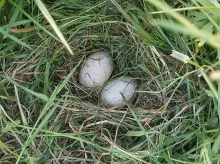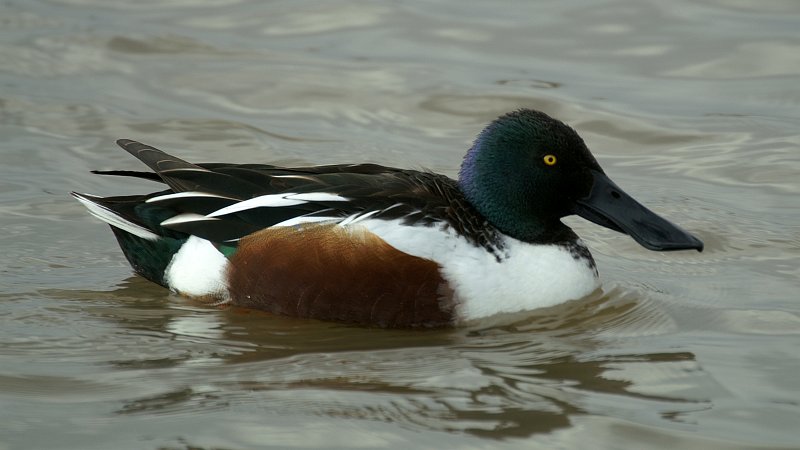
Northern shoveler (Anas clypeata)
Species name
- Dutch name:
- Slobeend
- English name:
- Northern shoveler
- German name:
- Löffelente
- French name:
- Canard souchet
- Scientific name:
- Anas clypeata
Scientific classification
- Order:
- Anseriformes
- Family:
- Anatidae
- Onderfamilie:
- Anatinae
- Genus:
- Anas
Description
- Description:
Male:
Head dark iridescent green, except for dark brownish-black crown; appears black at a distance. Neck and breast white, with white stripe above chestnut flanks and belly .Pale blue forewing shows on resting or swimming Bird, while oval white patch at sides of rump partially obscured by long drooping, Black and white scapulars. Back, rump and tail converts black, sides of tail white. In flight, white breast, and pale blue forewing and green speculum with white stripe between, very obvious; under wing whitish with contrasting grey brown flight feathers. Very large spatulate Bill grey-black. Eye yellow. Feet and legs orange red.
eclipse plumage: Resembles dark female but more uniformly and redder brown; retains blue forewing and green speculum with white stripe. Molts back into breeding plumage from late Sept thru March all depends on the individual birds health From the migration, nutrition, and other stresses.Female:
Overall brown, well marked with pale buff to pink-buff edgings and mottlings. Paler on the head, with narrow dark eye stripe. Pale sides to tale. forewing of the wings grey-blue and speculum duller with grayish blue spots on each of the seconderies thru the white bar. Bill dark Brown too yellowish orange with black spots along the sides.Juvenile:
Dark head and underparts paler. When Young fledge at 8 weeks and flight feathers are grown out you can tell males from females by visible pure white bar in-between green iridescent speculum and baby blue forewing. Females have grayish blue spots on each individual secodrie feather thru the white bar. From late Sept Males eye starts to turn yellow from brown. Start to get some breeding plumage. But slowly molts into breeding plumage from late Sept thru March all depends on the individual birds health From the migration, nutrition, and other stresses. Still well have some brownish black spotting on chest amongst the white.
Standard Measurements
- Body Length (cm):
- The male (drake) of the Northern shoveler measures approximately 46-56 centimeters. The female measures approximately 46-53 centimeters.
- Body Weight (grams):
- The male will weight about 480-890 gram. The female will weight about 480-820 gram.
The weight is notoriously variable and can only be used as indication!
- Note:
Northern shovelers are hardy, but shelter should be provided in prolonged frosts. Warm, sunny ponds with shallow muddy water, shallow, well-grown shore vegetation and adjoining grass areas are preferred, particularly a large enclosure supporting natural animal food. Easy to manage but can be aggressive (somewhat territorial while nesting) and may be a problem in mixed collections, particularly while breeding, unless on a very large pool/lake.
Commonly bred in captivity. Nest in vegetation such as grass and reeds, eggs laid April to May or June. These are reliable breeders but susceptible to predators, therefore eggs removal is suggested. A second and even a third clutch may be laid if the clutches are removed. Ducklings may be delicate and difficult to get going initially. Fine-particle food dropped onto water useful for feeding ducklings initially, and live insects as well as starter crumbs, also duckweed.
These ducks may hybridise with other Anas spp. and hybrids have been reported also with Wood duck (Aix sponsa) , Ferruginous pochard (Aythya nyroca) and Muscovy duck (Cairina moschata), but not usually once firmly paired.
The shoveler prefers to nest in grassy areas away from open water. Their nest is a shallow depression on the ground, lined with plant material and down. The drakes are very territorial during breeding season and will defend their territory and partners from competing males.
- Breeding:
- The female Northern shoveler usually lays from 8-12 cream to pale buff eggs and incubates them for 26-28 days.
- Artificial incubating:
The ideal relative humidity for incubating most waterfowl eggs is 55% (ground nesters) and 40% (cavity nesters). The temperature is usually 37.4°C. Set ventilation as recommended by the incubator manufacturer. Eggs must be turned, either automatically or by hand, a minimum of 4 times a day. As the duckling develops there is a loss of water from the egg and the air sac gets bigger. In normal development of an egg with a 26-28 days incubation, the air sac occupies about a third of it three days earlier. Cleanliness is vital and ideally eggs should be moved to a separate hatcher at this point, where the humidity should be increased to 65% and even higher once they have pipped internally.
- Bird banding:
- Recommended closed leg band ring size for the Northern shoveler is 9 mm.The leg band ring can only be applied on a young duck at around 12 days old.
- It doesn't matter what leg that you band, but it's good to have a consistent system. Suggested: Left leg = Female, Right leg = Male
- Rearingfeed:
-
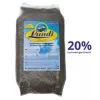
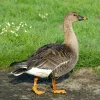

Floatable special rearing feed for all types of aquatic ornamental fowl - especially for the cultivation of trees as well as greening ducks.
This well-balanced complete feed with 20% protein content convinces above all by its good compatibility and forms the basis for visibly healthy growth from day one.
Made exclusively from wholesome and selected raw materials, Lundi Micro Regular is also ideally suited for the year-round feeding of waterfowl.
- Maintenance food:
-


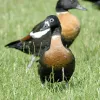


Floating full food for all sea ducks, green ducks, eider ducks and geese, especially in the moulting and breeding phase ideally suited. Packed with wholesome raw materials, natural vitamins and trace elements, this performance food with a protein content of 30% forms the basis for lifelong vitality.
- Regulation:
- Europese soort
- Regulation:
Het is niet verboden om deze vogels te houden die van nature in Nederland voorkomen, op voorwaarde dat deze vogels in gevangenschap zijn geboren; nakweek dus. Deze vogels zijn voorzien van een gesloten pootring. Het is wel verboden om deze vogels te houden die in het wild gevangen zijn. Alleen bepaalde instanties, zoals vogelasiels en vogelhospitalen, zijn bevoegd om jonge en gewonde wilde vogels te houden. Deze bescherming van vogels wordt vormgegeven door schadelijke handelingen te verbieden zoals:het doden, verwonden, vangen, bemachtigen en met het oog daarop opsporen van vogels (art. 9 Flora- en faunawet); het opzettelijk verontrusten van vogels (art. 10 Flora- en faunawet);het beschadigen, vernielen, uithalen, wegnemen en verstoren van nesten, holen of andere voortplantings- of vaste rust- of verblijfplaatsen van vogels (art. 11 Flora- en faunawet);en het zoeken, rapen, uit het nest nemen, beschadigen of vernielen van eieren van vogels (art. 12 Flora- en faunawet).

